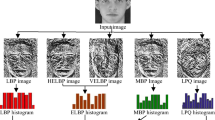Abstract
Local feature-based approaches mainly aim to achieve robustness to variations in facial images by assuming that only some parts of the facial images may be affected. However, such approaches may lose spatial information. In this study, a compromise feature extraction scheme is studied which extracts local features while preserving spatial information. The proposed scheme exploits an ensemble of classifiers where each member is constructed using randomly selected design parameters including the size, number and location of sub-images for local feature extraction. Experiments conducted on FERET and ORL databases have shown that proposed scheme surpasses the local feature-based reference systems which focus on either local information or preserving spatial information.












Similar content being viewed by others
References
Gottumukkal R, Asari VK (2004) An improved face recognition technique based on modular PCA approach. Pattern Recogn Lett 25:429–436
Chen S, Zhu Y (2004) Subpattern-based principle component analysis. Pattern Recogn 37:1081–1083
Turk M, Pentland A (1991) Eigenfaces for recognition. Cogn Neurosci 3(1):71–86
Tan K, Chen S (2005) Adaptively weighted sub-pattern PCA for face recognition. Neurocomputing 64:505–511
Silva H, Fred A (2007) Feature subspace ensembles: a parallel classifier combination scheme using feature selection. In: Haindl M, Kittler J, Roli F (eds) Multiple classifier systems, MCS 2007. LNCS 4472, Springer, Berlin
Ho TK (1998) The random subspace method for constructing decision forests. IEEE Trans Pattern Anal Mach Intell 20(8):832–844
Krogh A, Vedelsby J (1995) Neural network ensembles, cross validation, and active learning. In: Tesauro G, Touretzky D, Leen T (eds) Advances in neural information processing systems, vol 7. The MIT Press, Cambridge, pp 231–238
Zhou Z, Yu Y (2005) Ensembling local learners through multimodal perturbation. IEEE Trans Syst Man Cybern B Cybern 35(4):725–735
Whitaker CJ, Kuncheva LI (2003) Examining the relationship between majority vote accuracy and diversity in bagging and boosting. Technical Report. School of Informatics, University of Wales, Bangor
Opitz D, Maclin R (1999) Popular ensemble methods: an empirical study. J Artif Intell Res 11:169–198
Zenobi G, Cunningham P (2001) Using diversity in preparing ensembles of classifiers based on different feature subsets to minimize generalization error. In: Raedt LD, Flach PA (eds) Proceedings of the 12th conference on machine learning. Lecture Notes in Computer Science, vol 2167, pp 576–587
Melville P, Mooney RJ (2003) Constructing diverse classifier ensembles using artificial training examples. In: Proceedings of the IJCAI, pp 505–510
Ho TK (1998) Nearest neighbors in random subspaces. In: Amin A, Dori D, Pudil P, Freeman H (eds) Lecture Notes in Computer Science. Springer, Germany, pp 640–648
Heisele B, Serre T, Poggio T (2007) A component-based framework for face recognition and identification. Int J Comput Vis 74(2):167–181
Ullman S, Vidal-Naquet M, Sali E (2002) Visual features of intermediate complexity and their use in classification. Nat Neurosci 5(2):682–687
Su Y, Shan S, Chen X, Gao W (2006) Patch-based Gabor Fisher classifier for face recognition. In: Proceedings of the 18th international conference on pattern recognition (ICPR’06)
Ekenel HK, Stiefelhagen R (2009) Generic versus salient region-based partitioning for local appearance face recognition. Advances in biometrics. Lecture Notes in Computer Science, vol 5558/2009. Springer, Berlin, pp 367–375
Liu DH, Lam KM, Shen LS (2004) Optimal sampling of Gabor features for face recognition. Pattern Recogn Lett 25:267–276
Duda RO, Hart PE, Stork DG (2001) Pattern classification. John Wiley & Sons, New York
Liu C, Wechsler H (2002) Gabor feature based classification using the enhanced Fisher linear discriminant model for face recognition. IEEE Trans Image Process 11(4):467–476
Shen L, Bai L (2006) Mutual Boost learning for selecting Gabor features for face recognition. Pattern Recogn Lett 27:1758–1767
Breiman L (1996) Bagging predictors. Mach Learn 24:123–140
Lazarevic A, Fiez T, Obradovic Z (2001) Adaptive boosting for spatial functions with unstable driving attributes. Intell Data Anal 5:1–24
Zhou Z, Yu Y (2005) Adapt bagging to nearest neighbor classifiers. J Comput Sci Technol 20(1):48–54
Philips PJ, Wechsler H, Huang J, Rauss P (1998) The FERET database and evaluation procedure for face-recognition algorithms. Image Vis Comput 16:295–306
The ORL face database. http://www.cl.cam.ac.uk/research/dtg/attarchive/facedatabase.html
Alpaydın E (2004) Introduction to machine learning. The MIT Press, Cambridge
Demirekler M, Altınçay H (2002) Plurality voting based multiple classifier systems: statistically independent with respect to dependent classifier sets. Pattern Recogn 35(11):2365–2379
Lin X, Yacoub S, Burns J, Simske S (2003) Performance analysis of pattern classifier combination by plurality voting. Pattern Recogn Lett 24:1959–1969
Hansen LK, Salamon P (1990) Neural network ensembles. IEEE Trans Pattern Anal Mach Intell 12(10):993–1001
Acknowledgments
This work is supported by the research grant MEKB-07-06 provided by the Ministry of Education and Culture of Northern Cyprus. We would also like to thank to our colleagues Hüseyin Sertbay and Cem Ergün for their contributions in preprocessing image databases.
Author information
Authors and Affiliations
Corresponding author
Rights and permissions
About this article
Cite this article
Toygar, Ö., Altınçay, H. Preserving spatial information and overcoming variations in appearance for face recognition. Pattern Anal Applic 14, 67–75 (2011). https://doi.org/10.1007/s10044-010-0188-4
Received:
Accepted:
Published:
Issue Date:
DOI: https://doi.org/10.1007/s10044-010-0188-4




